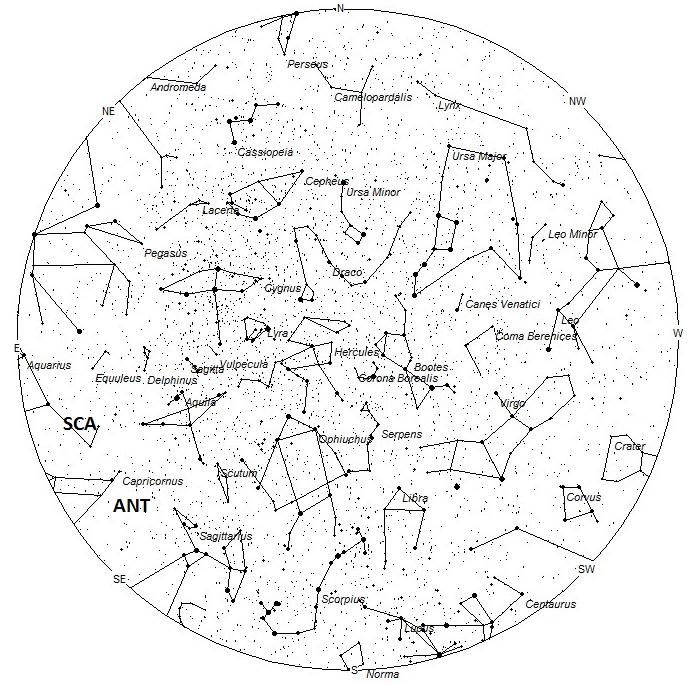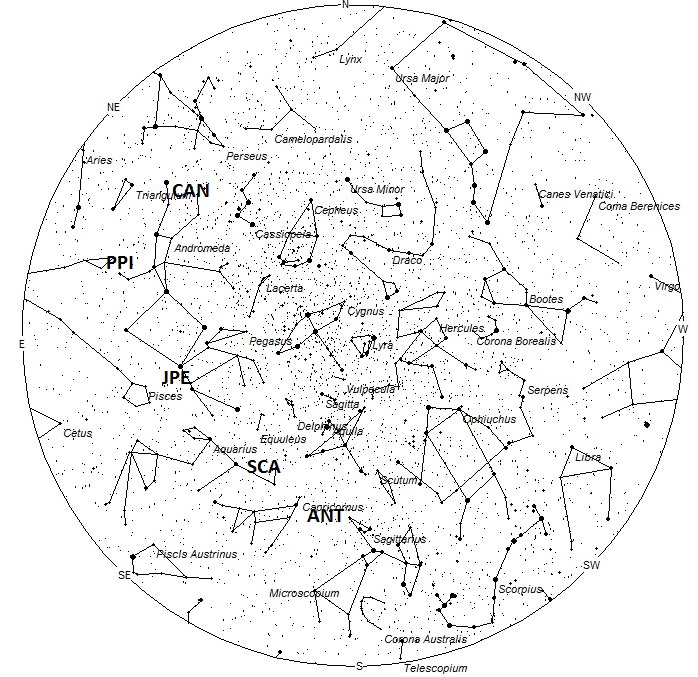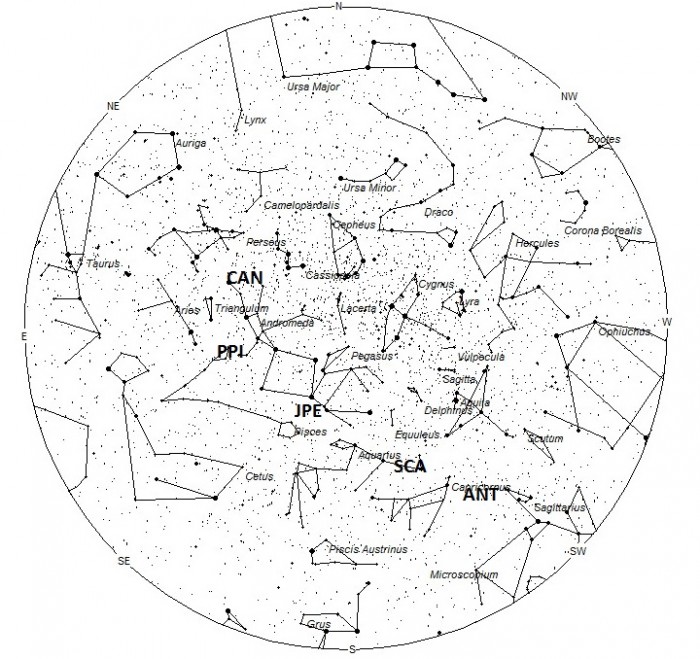During this period the moon reaches its new phase on Monday July 8th. At this time the moon is located near the sun and is not visible at night. As the week progresses the waxing crescent moon will enter the evening sky but will set long before the more active morning hours arrive. The estimated total hourly meteor rates for evening observers this week is near three as seen from the northern hemisphere and four as seen from south of the equator. For morning observers the estimated total hourly rates should be near sixteen no matter your location. The actual rates will also depend on factors such as personal light and motion perception, local weather conditions, alertness and experience in watching meteor activity.
The radiant (the area of the sky where meteors appear to shoot from) positions and rates listed below are exact for Saturday night/Sunday morning July 6/7. These positions do not change greatly day to day so the listed coordinates may be used during this entire period. Most star atlases (available at science stores and planetariums) will provide maps with grid lines of the celestial coordinates so that you may find out exactly where these positions are located in the sky. A planisphere or computer planetarium program is also useful in showing the sky at any time of night on any date of the year. Activity from each radiant is best seen when it is positioned highest in the sky, either due north or south along the meridian, depending on your latitude. It must be remembered that meteor activity is rarely seen at the radiant position. Rather they shoot outwards from the radiant so it is best to center your field of view so that the radiant lies at the edge and not the center. Viewing there will allow you to easily trace the path of each meteor back to the radiant (if it is a shower member) or in another direction if it is a sporadic. Meteor activity is not seen from radiants that are located below the horizon. The positions below are listed in a west to east manner in order of right ascension (celestial longitude). The positions listed first are located further west therefore are accessible earlier in the night while those listed further down the list rise later in the night.
The following shower are expected to be active this week:
The center of the large Anthelion (ANT) radiant is currently located at 19:24 (298) -20. This position lies in a remote area of eastern Sagittarius. The nearest bright star is third magnitude Dabih (Beta Capricornii), which lies ten degrees to the northeast. Due to the large, oval-shaped radiant, activity from this source may also be seen coming from western Capricornus, southern Aquila, Microscopium, and Scutum. These meteors may be seen all night long but the radiant is best placed near 0200 LDT when it lies on the meridian and is highest in the sky. Rates at this time should be near one per hour as seen from the Northern hemisphere and two per hour from south of the equator . With an entry velocity of 30 km/sec., the average Anthelion meteor would be of slow velocity.
The Sigma Capricornids (SCA) were discovered by Zdenek Sekanina and are active for a month lasting from June 19 through July 24. Maximum activity occurred on June 27th. The radiant is currently located at 21:00 (315) -05. This area of the sky is actually located in western Aquarius, eight degrees west of the third magnitude star known as Sadalsuud (Beta Aquarii). The radiant is best placed near 0300 LDT when it lies on the meridian and is highest in the sky. Rates at this time should be near two per hour no matter your location. With an entry velocity of 42 km/sec., the average Sigma Capricornid meteor would be of medium velocity. This velocity is significantly faster than the stronger Alpha Capricornids, which appear from the same general area of the sky during the second half of July.
The July Pegasids (JPE) were discovered by Peter Jenniskens during his study of annual streams during the late 80’s and early 90’s. This source is active with low rates during most of July with maximum activity occurring on the 10th. The radiant is currently located at 23:08 (345) +11. This area of the sky lies in southern Pegasus, six degrees south of the second magnitude star Markab (Alpha Pegasi). This radiant is best placed during the last dark hour before dawn, when it lies highest above the horizon in a dark sky. Rates at this time should be near one per hour no matter your location. With an entry velocity of 68 km/sec., the average July Pegasid meteor would be of swift speed.
The Pi Piscids (PPI) is a new source of activity discovered by Dr. Peter Brown and his Canadian Meteor Orbit Radar (CMOR) team. Activity is found from this source throughout June and July. Maximum activity occurred on July 1st. The radiant is currently located at 01:14 (018) +26. This area of the sky is located in northern Pisces, three degrees northeast of the fourth magnitude star Eta Andromedae. The radiant is best placed near 0300 LDT when it lies on the meridian and is highest in the sky. Rates at this time should be near two per hour as seen from the northern hemisphere and one per hour as seen from south of the equator. With an entry velocity of 69 km/sec., the average Pi Piscid meteor would be of swift velocity.
The c-Andromedids (CAN) was discovered by Sirko Molau and Juergen Rendtel using video data from the IMO network. Activity from this source is seen from June 26 though July 20 with maximum activity occurring on July 10. The radiant currently lies at 01:50 (027) +46, which places it in northeastern Andromeda, five degrees northwest of the famous second magnitude double star Almach (Gamma Andromedae). This area of the sky is best seen during the last dark hour before dawn when the radiant lies highest in a dark sky. Observers in the northern hemisphere are better situated to view this activity as the radiant rises much higher in the sky before dawn as seen from northern latitudes. Current rates would be 1-2 shower members as seen from the northern hemisphere before dawn and less than one per hour for observers situated south of the equator. With an entry velocity of 60 km/sec., the average meteor from this source would be of swift velocity.
As seen from the mid-northern hemisphere (45N) one would expect to see approximately eight sporadic meteors per hour during the last hour before dawn as seen from rural observing sites. Evening rates would be near two per hour. As seen from the mid-southern hemisphere (45S), morning rates would be near ten per hour as seen from rural observing sites and three per hour during the evening hours. Locations between these two extremes would see activity between the listed figures.
The table below presents a list of radiants that are expected to be active this week. Rates and positions are exact for Saturday night/Sunday morning.
| SHOWER | DATE OF MAXIMUM ACTIVITY | CELESTIAL POSITION | ENTRY VELOCITY | CULMINATION | HOURLY RATE | CLASS |
| RA (RA in Deg.) DEC | Km/Sec | Local Daylight Time | North-South | |||
| Anthelions (ANT) | – | 19:24 (298) -20 | 30 | 02:00 | 1 – 2 | II |
| Sigma Capricornids (SCA) | Jun 27 | 21:00 (315) -05 | 42 | 03:00 | 2 – 2 | IV |
| July Pegasids (JPE) | Jul 10 | 23:08 (345) +11 | 68 | 05:00 | 1 – 1 | IV |
| Pi Piscids (PPI) | Jul 01 | 01:14 (018) +26 | 69 | 07:00 | 2 – 1 | IV |
| c-Andromedids (CAN) | Jul 10 | 01:50 (027) +46 | 60 | 07:00 | 2 – <1 | IV |
 American Meteor Society
American Meteor Society


